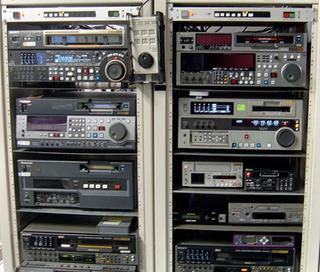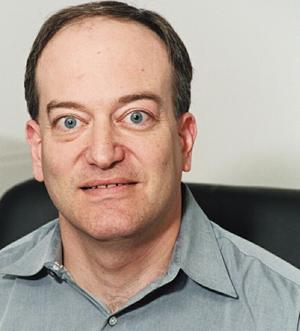Transferring SD Video: A Conversation with Mike Weiss

Equipment racks at Video Labs have a wide range of playback machines.
ALEXANDRIA, VA.—There are probably billions of hours of programming, news and memories recorded on decaying standard-definition analog videotape. If this material is to be preserved, it needs to be transferred to a digital format.
There are companies that specialize in transferring video from legacy analog formats (such as 3/4-inch U-Matic, Betacam, VHS, 1-inch, and many others) to modern digital formats. One such company is Rockville, Md.-based Video Labs.
Mike Weiss, the CEO of Video Labs, shed some light on the process of converting old analog video into digital.
BE Extra: There are probably lots of consumers who want to transfer wedding and baby VHS videos to a digital format, but what old professional formats do you see today?
Weiss: MiniDV, 8mm, VHS, Hi8, DVCam, Betamax, Betacam SP, one-inch and 3/4-inch comprise the majority of “old” formats that are presented for some type of conversion. For consumers, VHS and mini tape (MiniDV or DVCam) are most popular, while organizations seeking to archive footage will provide us (most often) with VHS and Betacam SP.
BE Extra: What are a couple of the biggest issues in transferring from a legacy videotape format to a digital format? Do you need to use timebase correction or other stabilization?
Get the TV Tech Newsletter
The professional video industry's #1 source for news, trends and product and tech information. Sign up below.
Weiss: Videotape formats present different challenges. For example, 3/4-inch has a tendency to clog deck heads, thus there’s maintenance effort in addition to conversion time applied to a digital transfer using this format. VHS has 250 lines of resolution and, when converting to a high-quality digital file such as an Apple ProRes codec, the video quality does not convey—poor quality video improved just a bit on the digital file. Timebase correction is used along with individual deck controls [to get the maximum possible quality].

Mike Weiss
BE Extra: Are there legacy video formats that you don’t see anymore, such as two-inch quad? If there is an apparently dead format, when was the last time you saw one of those tapes?
Weiss: Two-inch quad is the only format we never encounter at Video Labs. One reason can be attributed to the massive piece of equipment needed to play back that format.
BE Extra: Do you have any issues keeping your legacy machines functioning? What are the sorts of things you need to do to keep these machines running?
Weiss: Legacy decks need loving care, just as digital media resources do. We do have technicians clean decks with tape head cleaners, but we also bring in maintenance engineers to provide repair and service. As we have multiple decks of the same format, it’s common to interchange parts.
BE Extra: Is there any particular legacy machine that is especially difficult to keep running properly? Which one and why is it a problem?
Weiss: 3/4-inch is a problem child. Machine heads get dirty quicker using this analog format than with other older tape options.
BE Extra: What are the two or three most popular digital formats for transfers?
Weiss: Apple ProRes and QuickTime H.264 are popular digital files. Each of those file types have options (ProRes: 422 or 444; HQ or LT/QT; H.264 or mpeg4; compressed or uncompressed).
BE Extra: Have you ever had a really unusual request for a destination format?
Weiss: I wouldn’t consider our requests unusual. However, there are many options to be considered based on the distribution method and type of airing. For example, digital file specs (frame size and frame rate) vary based on where that file will be viewed. With digital video that is being used for broadcast, captioning and tracking signals (SpoTTrac) come in to play. So, it’s not unusual for Video Labs to work with many different digital file specifications and requests.
BE Extra: Anything else we should know about the technology and operation of copying legacy video formats to current digital standards?
Weiss: The most common feedback we get after transferring legacy formats to digital files is, “It doesn't look as good as I thought it would.” And that’s because we’re essentially manipulating analog source material and pushing it into a “holder” of better quality. Converting old analog video to any other format is simply not going to look as good as using native digital sources and making an exact replica.
Bob Kovacs is the former Technology Editor for TV Tech and editor of Government Video. He is a long-time video engineer and writer, who now works as a video producer for a government agency. In 2020, Kovacs won several awards as the editor and co-producer of the short film "Rendezvous."

